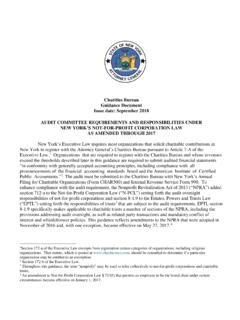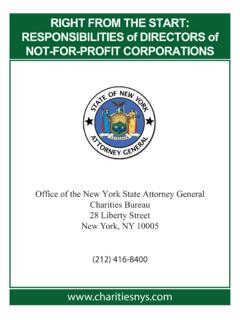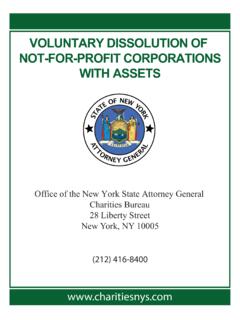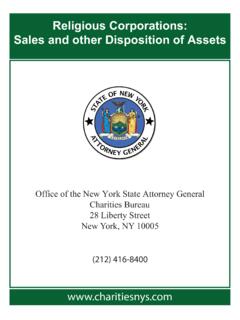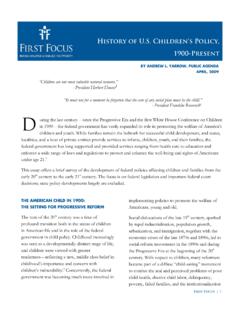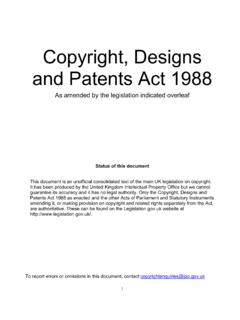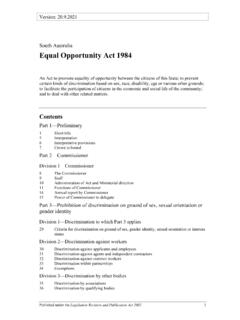Transcription of Conflicts of Interest Policies Under the Not-For-Profit ...
1 Conflicts of Interest Policies Under the Not-For-Profit Corporation Law charities Bureau Guidance Document Issue date: September 2018. Conflicts of Interest for board members are almost inevitable in Not-For-Profit corporations, and the existence of Conflicts of Interest should not disqualify board service. In fact, board members with significant community and business relationships are valuable because of the contacts and expertise they bring to the board, and more likely to have Conflicts arising from those relations. An effective conflict of Interest policy allows a Not-For-Profit entity to benefit from engaged and sophisticated board members, and to manage conflict of Interest issues in ways that provide reassurance that the mission of the entity remains paramount. This guidance has been drafted to assist Not-For-Profit corporations and trusts (hereafter collectively nonprofits ) that are drafting, reviewing, or revising their Conflict of Interest Policies and adopting and implementing those Policies .
2 It has been up-dated to reflect amendments to the Not-For-Profit Corporation Law ( N- PCL that were enacted in November of 2016 and, with one exception, became effective on May 27, 2017 1. The guidance is not intended to serve as a substitute for advice from a nonprofit's attorney, nor should it be construed to have anticipated or addressed every issue that a nonprofit should consider or address when drafting or implementing its policy. 11. An amendment to Not-For-Profit Corporation Law 713(f) that permits an employee to be the board chair Under certain circumstances became effective on January 1, 2017. 1. The N-PCL follows both common law and best practices literature in requiring directors to make disclosures about potential Conflicts of Interest at the beginning of their service, and on an annual basis thereafter. It also requires directors, officers and key persons (called key employees prior to the 2016 amendments) 2.)
3 To disclose potential Conflicts of Interest in issues that come before the board and to refrain from participating in board deliberations and decisions on those issues. The N-PCL requires that a nonprofit's procedures for disclosing and resolving Conflicts of Interest be set forth in a Conflict of Interest Policy adopted by the board. The Conflict of Interest Policy adopted by the Board must reflect the minimum standards set forth in N-PCL Section 715-a. Where a director, officer, or key person has a conflict of Interest , as defined by a nonprofit's Conflict of Interest Policy, in an issue coming before the board, that individual must disclose the circumstances giving rise to the conflict, and the nonprofit has an obligation to make a record of the existence of the conflict and how it was addressed, both with respect to that individual and with respect to the transaction.
4 Director, officer, key person, related party and relative are all terms that are defined in the N-PCL. See N-PCL 102(a)(6), 102(a)(22), 102(a)(23), 102(a)(25), 713(f). A 2016 amendment to the N-PCL replaced the term Key employee with the term key person and defined a key person as someone who is not an officer or director and who, whether or not employed by the corporation, has responsibilities or powers similar to those of officers and directors, manages the corporation of a substantial part of its activities, assets or finances, or has a role in controlling a substantial part of its capital expenditures or budget. A key person might be A founder who, although he or she has no title or official role, exercises apparent authority over the organization, or A substantial donor who, although he or she has no official role or title in the organization, participated in setting the agenda and making employment decisions.
5 2. The amendments changed the term key employee to key person and amended the definition of that term. An explanation of the change is included later in this guidance. 2. Conflict of Interest Policy: Minimum Statutory Requirements The board of each nonprofit must adopt, implement and oversee compliance with a Conflict of Interest Policy to ensure that its directors, officers, and key persons act in the [nonprofit's] best Interest and comply with applicable legal requirements.. The policy must cover Conflicts and possible Conflicts of Interest , including related party transactions, which are defined by the N-PCL as transactions, agreements or arrangements in which a related party has a financial Interest and in which the nonprofit or an affiliate is a participant. The policy may also cover other types of Conflicts that may exist even though there is no financial Interest at stake or the circumstances are otherwise outside the definition of a related party transaction.
6 The Conflict of Interest Policy must include: 1. A definition of the circumstances that constitute a conflict of Interest (N- PCL 715-a(b)(1)). The statute gives the Board of Directors discretion to define the circumstances that constitute a conflict of Interest , including the discretion to define exceptions for de minimis transactions and ordinary course of business transactions not covered by the policy. The board also has discretion to define the procedures that should be followed for different types of Conflicts . This discretion includes the power to define additional restrictions on transactions between a board member and the corporation, or between the nonprofit's employees and third parties (for example, by articulating a no acceptance of gifts policy, a no nepotism policy, or by incorporating Food and Drug Administration or Public Health Service conflict standards into a university's conflict policy).
7 In addition, there may be circumstances specific to the organization that involve dual interests but do not present a significant risk of conflicting loyalties. For example, religious corporations in their charter or by-laws frequently will include directors who are members of religious orders, employees of sponsoring or related churches, or bishops who, by canon law, hold title to all property of related religious corporations and may be called upon to approve the disposition of that property. City-related nonprofits may define circumstances that constitute a 3. conflict of Interest to exclude the responsibility of an ex-officio director to the electorate or the city appointing official, particularly where such ex-officio role is specifically set forth in the nonprofit's enabling legislation , charter or certificate of incorporation, since the role and definition of the ex-officio includes the responsibility of advocating a broader public Interest in board discussions, and that role is clear to all non-city directors.
8 2. Procedures for disclosing a conflict of Interest to the board or a committee or the board (N-PCL 715-a(b)(2)). These procedures may include expectations for each class of conflict reporters, forms, record-keeping, custodians; disclosure to other persons within the nonprofit or to third parties, timing, and committee review and action. 3. Requirement that the person with the conflict of Interest not be present at or participate in board or committee deliberations or vote on the matter giving rise to such conflict. (N-PCL 715-a(b)(3)). The language of the statute refers only to board or committee deliberations and votes. It is recommended that the board adopt a more comprehensive policy that articulates standards of conduct for board members, officers and key persons regarding Conflicts of Interest , disclosure requirements, reporting requirements, and procedures for mitigation.
9 In the board or committee setting, however, the board may request that the person with the conflict of Interest present information as background or answer questions at a committee or boards meeting prior to the commencement of deliberations or voting. 4. Prohibition of any attempt by the person with the conflict to influence improperly the deliberations or voting on the matter giving rise to such conflict. (N-PCL 715-a(b)(4)). Improperly influence in this context should have a meaning similar to that used by the Securities and Exchange Commission in addressing improperly influencing audits: coercing, manipulating, misleading, or fraudulently influencing (collectively referred to herein as "improperly influencing") the decision-making when the officer, director or other person knew or should have known that the 4. action, if successful, could result in the outcome which the officer or director could not deliberate or vote on directly.
10 ( Improper Influence on Conduct of Audits, ). 5. Requirement that existence and resolution of a conflict be properly documented, including in the minutes of any meeting at which the conflict was discussed or voted upon. (N-PCL 715-a(b)(5)). 6. Procedures for disclosing, addressing, and documenting related party transactions pursuant to N-PCL 715. Related party transactions include any transaction, agreement, or other arrangement in which a related party has a direct or indirect financial Interest and in which the nonprofit or an affiliate participates. (N-PCL 715-a(b)(6)). A person has an indirect financial Interest in an entity if a relative, as defined by the N-PCL, has an ownership Interest in that entity or if the person has ownership in an entity that has ownership in a partnership or professional corporation. This is consistent with the definition of indirect ownership Interest that is found in the instructions to Form 990, Schedule L.



